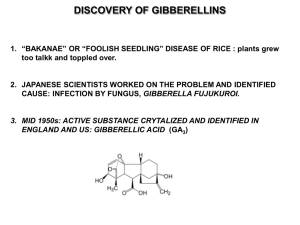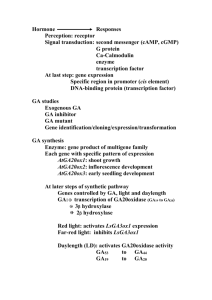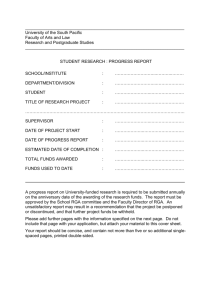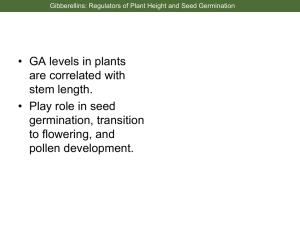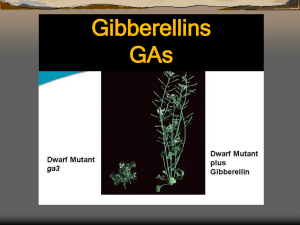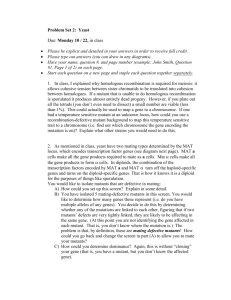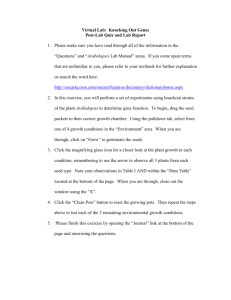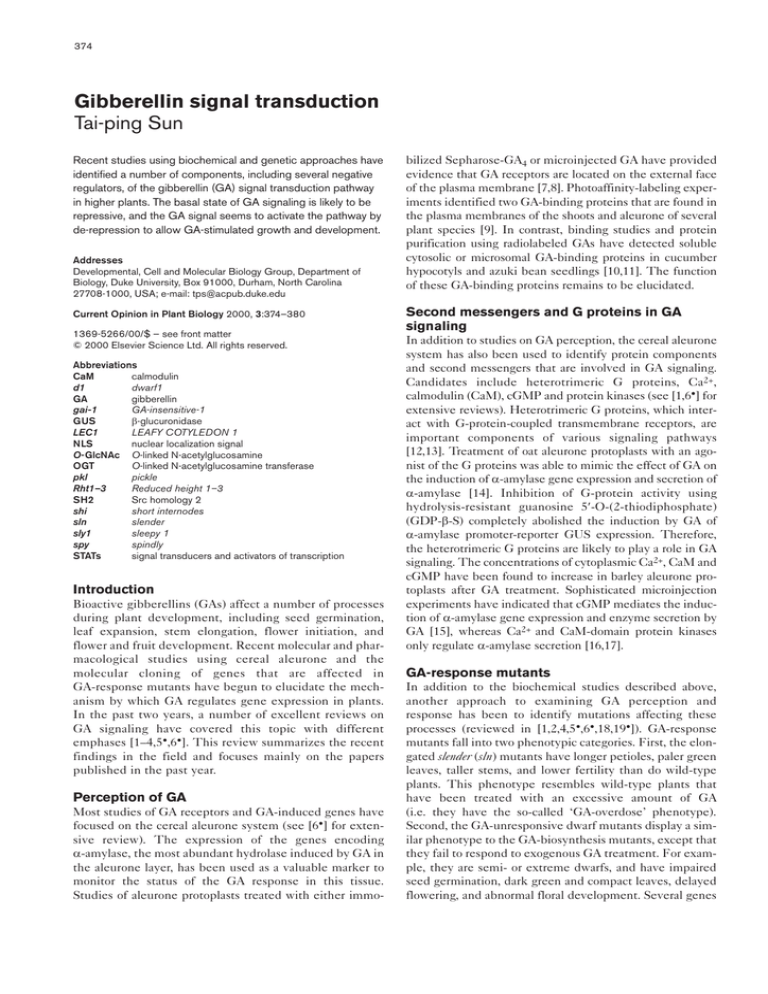
374
Gibberellin signal transduction
Tai-ping Sun
Recent studies using biochemical and genetic approaches have
identified a number of components, including several negative
regulators, of the gibberellin (GA) signal transduction pathway
in higher plants. The basal state of GA signaling is likely to be
repressive, and the GA signal seems to activate the pathway by
de-repression to allow GA-stimulated growth and development.
Addresses
Developmental, Cell and Molecular Biology Group, Department of
Biology, Duke University, Box 91000, Durham, North Carolina
27708-1000, USA; e-mail: tps@acpub.duke.edu
Current Opinion in Plant Biology 2000, 3:374–380
1369-5266/00/$ — see front matter
© 2000 Elsevier Science Ltd. All rights reserved.
Abbreviations
CaM
calmodulin
d1
dwarf1
GA
gibberellin
gai-1
GA-insensitive-1
GUS
β-glucuronidase
LEC1
LEAFY COTYLEDON 1
NLS
nuclear localization signal
O-GlcNAc O-linked N-acetylglucosamine
OGT
O-linked N-acetylglucosamine transferase
pkl
pickle
Rht1–3
Reduced height 1–3
SH2
Src homology 2
shi
short internodes
sln
slender
sly1
sleepy 1
spy
spindly
STATs
signal transducers and activators of transcription
Introduction
Bioactive gibberellins (GAs) affect a number of processes
during plant development, including seed germination,
leaf expansion, stem elongation, flower initiation, and
flower and fruit development. Recent molecular and pharmacological studies using cereal aleurone and the
molecular cloning of genes that are affected in
GA-response mutants have begun to elucidate the mechanism by which GA regulates gene expression in plants.
In the past two years, a number of excellent reviews on
GA signaling have covered this topic with different
emphases [1–4,5•,6•]. This review summarizes the recent
findings in the field and focuses mainly on the papers
published in the past year.
Perception of GA
Most studies of GA receptors and GA-induced genes have
focused on the cereal aleurone system (see [6•] for extensive review). The expression of the genes encoding
α-amylase, the most abundant hydrolase induced by GA in
the aleurone layer, has been used as a valuable marker to
monitor the status of the GA response in this tissue.
Studies of aleurone protoplasts treated with either immo-
bilized Sepharose-GA4 or microinjected GA have provided
evidence that GA receptors are located on the external face
of the plasma membrane [7,8]. Photoaffinity-labeling experiments identified two GA-binding proteins that are found in
the plasma membranes of the shoots and aleurone of several
plant species [9]. In contrast, binding studies and protein
purification using radiolabeled GAs have detected soluble
cytosolic or microsomal GA-binding proteins in cucumber
hypocotyls and azuki bean seedlings [10,11]. The function
of these GA-binding proteins remains to be elucidated.
Second messengers and G proteins in GA
signaling
In addition to studies on GA perception, the cereal aleurone
system has also been used to identify protein components
and second messengers that are involved in GA signaling.
Candidates include heterotrimeric G proteins, Ca2+,
calmodulin (CaM), cGMP and protein kinases (see [1,6•] for
extensive reviews). Heterotrimeric G proteins, which interact with G-protein-coupled transmembrane receptors, are
important components of various signaling pathways
[12,13]. Treatment of oat aleurone protoplasts with an agonist of the G proteins was able to mimic the effect of GA on
the induction of α-amylase gene expression and secretion of
α-amylase [14]. Inhibition of G-protein activity using
hydrolysis-resistant guanosine 5′-O-(2-thiodiphosphate)
(GDP-β-S) completely abolished the induction by GA of
α-amylase promoter-reporter GUS expression. Therefore,
the heterotrimeric G proteins are likely to play a role in GA
signaling. The concentrations of cytoplasmic Ca2+, CaM and
cGMP have been found to increase in barley aleurone protoplasts after GA treatment. Sophisticated microinjection
experiments have indicated that cGMP mediates the induction of α-amylase gene expression and enzyme secretion by
GA [15], whereas Ca2+ and CaM-domain protein kinases
only regulate α-amylase secretion [16,17].
GA-response mutants
In addition to the biochemical studies described above,
another approach to examining GA perception and
response has been to identify mutations affecting these
processes (reviewed in [1,2,4,5•,6•,18,19•]). GA-response
mutants fall into two phenotypic categories. First, the elongated slender (sln) mutants have longer petioles, paler green
leaves, taller stems, and lower fertility than do wild-type
plants. This phenotype resembles wild-type plants that
have been treated with an excessive amount of GA
(i.e. they have the so-called ‘GA-overdose’ phenotype).
Second, the GA-unresponsive dwarf mutants display a similar phenotype to the GA-biosynthesis mutants, except that
they fail to respond to exogenous GA treatment. For example, they are semi- or extreme dwarfs, and have impaired
seed germination, dark green and compact leaves, delayed
flowering, and abnormal floral development. Several genes
Gibberellin signal transduction Sun
that are affected in these mutants have been cloned from
Arabidopsis and rice, and their orthologs were subsequently
cloned from additional species.
Recessive GA-unresponsive dwarf mutants and
positive regulators of GA signaling
Until now, most of the so-called GA-unresponsive dwarf
mutants have been identified solely on the basis of their
morphology to be phenocopies of GA-deficient mutants.
Because GA is not the only endogenous signal that induces
plant growth, it is essential to characterize dwarf mutants
precisely before classifying them as GA-response mutants
(i.e. mutants that are specifically defective in GA signaling).
In cereals, the ability of aleurone cells to produce α-amylase in response to GA has been useful in distinguishing
between different dwarf mutants. This approach assumes
that plants that are defective in the early components of GA
signaling should show an overall impaired GA response in
all tissues. The GA-response pathway may, however,
branch out to control different processes. Additional
GA-regulated marker genes are, therefore, needed to identify downstream components of GA signaling.
The dwarf1 (d1) mutants in rice [20], the gse (for GA-sensitivity) mutants in barley [21••], and the sleepy1 (sly1)
mutant in Arabidopsis [22] have a semi-dwarf phenotype,
which is similar to that of the leaky GA-biosynthesis
mutants. Exogenous GA treatment does not, however,
rescue the defective stem elongation of d1, gse or sly1
mutants. The d1 and gse mutations also prevented
GA-induced α-amylase gene expression in the aleurone
cells [20]. The recessive nature of these mutations
implies that these genes may encode positive regulators
of the GA signal transduction pathway. Recent cloning of
the D1 locus revealed that it encodes the putative α-subunit of the heterotrimeric G protein in rice [23••,24••].
This finding supports the results of earlier pharmacological studies, which showed that the heterotrimeric
G proteins are involved in GA signaling [14]. The sln
mutation (see below) is epistatic to gse [21••], indicating
that, in barley, SLN may act downstream of the GSE in
the GA-response pathway. The sly1 mutant was isolated as
a suppressor of the abi1-1 (for abcisicic-acid-insensitive-1-1)
mutation, but it cannot germinate in the wild-type ABI1
background [22]. Cloning of GSE and SLY1 will help to
reveal their roles in GA response.
Another Arabidopsis mutant, pickle (pkl), has the same shoot
phenotype as the GA-unresponsive dwarf mutants [25].
After germination, however, it has a unique embryonic root
phenotype, which is absent in other mutants defective in
either GA biosynthesis or the GA response. Because the
penetrance of this primary root phenotype was reduced by
GA application and enhanced by treatment with a GA
biosynthesis inhibitor, uniconazole, it has been proposed
that PKL mediates the GA-induced differentiation of roots
during germination [25]. Positional cloning of PKL
revealed that PKL contains sequence homology to the
375
CHD3 (for a chromo [chromatin-organization modifier]
domain, a helicase/ATPase domain, and a DNA-binding
domain) chromatin-remodeling factor, which regulates gene
expression by repression of transcription [26•]. Expression of
the embryo identity gene LEAFY COTYLEDON 1 (LEC1)
was de-repressed in the roots of pkl seedlings. Nevertheless,
repression of LEC1 by PKL is GA independent.
Recessive elongated (slender) mutants identify
negative regulators in GA signaling
The sln mutants [18] exhibit complete (e.g. la ; crys in pea
and sln in barley) or partial (spindly [spy] and rga (for
repressor of ga1-3) in Arabidopsis, and procera in tomato
[27•]) GA-independent growth response. These mutations are recessive, and therefore are likely to affect
negative regulators of GA signaling. The Arabidopsis
genes SPY and RGA have been isolated [28,29].
Germination of Arabidopsis seeds has an absolute requirement for GAs. SPY was identified because of the ability of
the mutant spy alleles to rescue seed germination in the
presence of a GA biosynthetic inhibitor, paclobutrazol [30].
Cloning of SPY [28] and its homolog in barley (HvSPY,
[31]) revealed that SPY is highly similar to the Ser/Thr
O-linked N-acetylglucosamine (O-GlcNAc) transferases
(OGT) in rat and humans [32]. OGTs modify target proteins by glycosylation of Ser/Thr residues, which either
interfere or compete with kinases for phosphorylation
sites. Like OGTs in animals, SPY contains tetratricopeptide repeats that are likely to be important for
protein–protein interaction [5•,33]. Transient expression of
HvSPY in barley aleurone protoplasts is able to inhibit
GA-induced α-amylase gene expression [31]. This result
further supports the role of SPY and HvSPY as repressors
of GA signaling. Although SPY has not been confirmed to
be OGT in planta, the insect-cell-produced SPY protein
did show OGT activity in vitro [5•].
RGA was identified because of the ability of recessive rga
alleles to partially suppress the phenotype of the
GA-biosynthesis mutant ga1–3 [34]. Cloning and characterization of the RGA gene revealed that the RGA protein
is most probably a transcriptional regulator, which
represses GA signaling in Arabidopsis ([29], see below).
The mutant early flowering 1 (eaf1) has recently been characterized [35•]. This recessive mutant has pale green
leaves and elongated petioles, and shows an increased
resistance to paclobutrazol during seed germination. It
has been proposed that EAF1 is a repressor that regulates
GA-induced germination and flowering by affecting
either GA concentrations or GA response.
Semi-dominant GA-unresponsive dwarf mutants
identify negative regulators in GA signaling
The GA-insensitive-1 (gai-1) mutant in Arabidopsis [36],
Reduced height 1–3 (Rht1–3) mutants in wheat [37], and D8
and D9 in maize [38] are semi-dominant GA-response
mutants. These mutants also accumulate high levels of
376
Cell signalling and gene regulation
bioactive GA1 [39–41], suggesting that their impaired GA
response upregulates GA biosynthesis via a feedback
mechanism (reviewed in [1,42•]). Nevertheless, because of
the semi-dominant (gain-of-function) nature of the mutations, the role of GAI, Rht and D8 and D9 in GA signaling
were unclear until the intragenic suppressors were isolated
and these genes were cloned.
The intragenic suppressors of gai-1 were isolated from
γ-ray- or fast-neutron-mutagenized and Ds-insertion lines
[43–45]. The loss-of-function (null) alleles created in these
ways restored the plant phenotype to wild-type. These
plants were, however, able to grow on media containing
paclobutrazol, indicating that the GA-response pathway
was partially de-repressed [45]. Thus, GAI is probably a
negative regulator of the GA response.
Cloning of GAI and RGA revealed that GAI and RGA share
82% sequence identity [29,45] and that they belong to the
plant-specific GRAS (for GAI, RGA, SCARECROW) family of regulatory proteins [46•]. To date, more than 33
GRAS family members have been identified in
Arabidopsis. All GRAS family members contain highly conserved central (VHIID) and carboxy-terminal (RVER)
regions, named after the conserved amino-acid motifs
(using the single letter code for amino acids) that are found
in each region [29,47]. The specific function of different
members may reside in the amino-terminal region, which
is divergent among the GRAS family members.
Both RGA and GAI have hallmarks of transcriptional regulators [29,45]. These include homopolymeric Ser and
Thr, Leu heptad repeats, and putative nuclear localization signals (NLSs). In support of an NLS function, the
green fluorescent protein (GFP)::RGA fusion protein was
shown to be in the nucleus both in onion epidermal cells
in a transient expression assay [29] and in stably transformed Arabidopsis plants (AL Silverstone, H-S Jung,
T-p Sun, unpublished data). RGA and GAI may act as coactivators or repressors by interacting with other
transcription factors because neither proteins contains a
well-defined DNA-binding domain.
Sequence analysis indicates that RGA and GAI have a
unique conserved region near the amino terminus called
DELLA, after a set of conserved amino acids [29]. This
region is likely to be involved in modulating GA response
because the gain-of-function gai-1 allele contains a
51-base-pair in-frame deletion within the DELLA region
[45]. Peng et al. [45] hypothesized that this deletion in the
gai-1 protein makes it a constitutive repressor of
GA response, whose activity cannot be inhibited by the
GA signal. More recently, two new GRAS family members
in Arabidopsis, RGA-like (RGL) [48] and RGA1-like
(GenBank accession number AC009895), have been identified and shown to contain the DELLA region. Future
reverse-genetics studies would help to determine whether
these proteins play a similar role in GA signaling.
Another GA-unresponsive dwarf Arabidopsis mutant, short
internodes (shi) was identified from a mutant population
generated by transposon insertion [49••]. This mutation is
semi-dominant, and its phenotype is caused by the overexpression of the SHI gene that is adjacent to the
CaMV-35S-promoter-containing transposon. On the basis
of the shi mutant phenotype, SHI was proposed to be a
negative regulator of GA signaling [49••]. Cloning of SHI
revealed that SHI is a putative zinc-finger transcription
factor. Isolation of loss-of-function shi alleles is essential to
rule out the possibility that over-expression and ectopic
expression of SHI may cause the dwarf phenotype by
interfering with components of the GA response.
Extragenic suppressors of gai-1
The dominant gar2-1 (for GA-responder) allele and leaky
spy alleles (e.g. spy-5 and spy-7) partially suppress all
defects of gai-1 mutants [44,50•]. In addition, the effects of
gar2-1 and spy-7 are additive, and in combination these
mutations restore the phenotype and GA levels of gai-1 to
those of the wild-type [50•]. Because gar2-1 is dominant, it
is difficult to predict the function of GAR2 in the GA signaling pathway at present. SPY was initially thought to
function downstream of GAI in the GA-response pathway
because the severe spy-4 allele was completely epistatic to
gai-1 [28]. Once SPY, GAI and RGA were cloned, an alternative model has been suggested ([5•,29,45], see below).
After taking account of the predicted biochemical functions of these genes, it was proposed that SPY may activate
RGA and GAI by GlcNAc modification.
Working model of GA signaling in Arabidopsis
Our model of GA signaling in Arabidopsis focuses on SPY,
RGA and GAI because the genetic interaction among these
three genes has been tested. OGT target sites are typically
rich in Ser/Thr and are found near Pro, Val or acidic
residues [51]. Both RGA and GAI contain such sequences
at their amino termini; hence, SPY may modify and activate RGA and GAI in GA-deficient conditions (Figure 1a)
[5•,29,45]. In animal systems, GlcNAc modification of proteins could facilitate their nuclear localization, increase
their stability, alter their protein–protein interaction and/or
compete with their phosphorylation [52,53]. The GA signal could inactivate RGA and GAI by inhibiting SPY,
and/or by increasing the phosphorylation of RGA and GAI,
or by activating an O-GlcNAc specific N-acetylglucosaminidase that removes GlcNAc residues (Figure 1b).
Previously, the rga and spy mutations were shown to have
additive effects in suppressing the defects of the ga1–3
mutants [34]. This observation would be consistent with
this model if RGA and GAI in the GA-deficient background still maintain a basal repressor activity without
activation by SPY. Future biochemical analyses are crucial
to verify this model. Because spy suppresses all defects in
ga1–3, but rga does not rescue the ga1–3 defects in seed
germination and flower development [30,34], GAI and/or
additional RGA/GAI homologs (e.g. RGL, RGA1-like) are
likely to be involved in these two GA-regulated processes.
Gibberellin signal transduction Sun
377
Figure 1
Proposed roles of SPY, GAI and RGA in the
GA signaling pathway. (a) A GA-deficient cell
in a GA-biosynthesis mutant or a wild-type
cell without the GA signal. The hypothetical
transmembrane GA receptor is inactive in the
absence of GA signal. In this situation, SPY*
is an active OGT. RGA and GAI become
activated RGA* and GAI* proteins upon
GlcNAc modification by SPY*. Active RGA*
and GAI* function as activators or repressors
of transcription, and indirectly or directly
inhibit the expression of GA-induced genes.
(b) A GA-responding cell in a wild-type plant.
The GA receptor (dark gray) is activated by
binding of bioactive GA. The GA signal
inhibits RGA and GAI not only by
deactivating SPY, but also by an unidentified
factor (?), which may deactivate RGA and
GAI through interaction with the DELLA
(a) GA-deficient cell
Cytoplasm
SPY*
GA receptor
Nucleus
GAI*
(b) Wild-type GA-responding cell
GA
Cytoplasm
SPY
GA receptor ?
Nucleus
RGA
RGA*
GAI
Transcription
of GA-activated
genes
Transcription
of GA-activated
genes
Current Opinion in Plant Biology
region. The intensity of signal coming from
the GA–receptor complex will determine the
level of SPY, RGA and GAI activities in a
Isolation of the functional orthologs of RGA and
GAI in crops
Yields of cereal crops around the world have increased dramatically since the 1950s, and this ‘Green Revolution’ was
greatly facilitated by the introduction of semi-dwarf wheat
varieties carrying the Rht mutations [37,54]. Today, almost
all of the commercial wheat varieties employ one of the Rht
mutant alleles. Interestingly, the wheat Rht-B1 and Rht-D1
genes and the maize d8 gene are, in fact, orthologs of RGA
and GAI [55••,56•]. Internal deletions or amino-terminal
truncations of the DELLA domain in the Rht and D8 proteins resulted in the semi-dominant dwarf phenotype in
wheat and maize, respectively. These results strongly support the hypothesis that the DELLA domain in the
GAI/RGA/Rht-B1/Rht-D1/d8 protein family is required to
modulate the activity of these proteins in response to the
GA signal. Presumably, deleting the DELLA region locks
the protein into a conformation that can no longer, or only
very weakly, respond to the GA signal. Sequence analysis
revealed a putative Src homology 2 (SH2) phosphotyrosine
binding domain in Rht/d8/GAI/RGA [55••]. This SH2
domain is known to mediate the binding of a family of
transcription factors in animals, called STATs (signal transducers and activators of transcription), to various receptor
tyrosine kinases [57]. Future biochemical studies are necessary to determine whether this SH2-like domain in
GAI/RGA/Rht/d8 has a similar function to that in STATs.
Recently, the RGA and GAI orthologs in barley and rice
have also been shown to be encoded by the SLN locus
(PM Chandler, A Marion-Poll, F Gubler, personal communication) and the SLENDER RICE (SLR) locus ([58];
J Yamaguchi, personal communication), respectively. A lossof-function mutation in SLN or SLR resulted in a ‘slender’
phenotype in barley and in rice, respectively, presumably
because of a constitutive derepression of GA signaling.
These data show that the activities of RGA and GAI
orthologs are highly conserved in both dicots and monocots.
given cell. Arrows and T-bars indicate positive
and inhibitory effects, respectively. *Active
forms of the proteins.
GA-regulated genes
To identify components involved in GA-mediated internode
elongation, early GA-induced genes were isolated from the
intercalary meristem of the deepwater rice (reviewed
in [59]). These include a leucine-rich repeat receptor-like
transmembrane protein kinase (OsTMK, [60•]) and a putative
transcription factor Os-GRF1 [61•]. Reverse-genetic and/or
antisense approaches may help researchers to understand the
function of these genes in GA signaling.
RGA and GAI appear to be transcriptional regulators, but
their downstream targets are unknown. Only a few genes
that are regulated by GA at the transcriptional level have
been isolated [62]. The α-amylase genes in barley aleurone are well studied (reviewed in [6•,63]) and could be
candidate targets for SLN. Induction of transcription of
these genes by GA requires the transcription factor
GAMYB [64,65]. A zinc-finger transcriptional repressor,
HRT, was found to inhibit GA-induced amylase expression in barley aleurone cells [66]. Further studies are
needed to clarify the relationships among SLN, GAMYB
and HRT in controlling the expression of α-amylase genes.
The transcription of genes involved in cell elongation, such
as the tonoplast intrinsic protein, γ-TIP, in Arabidopsis [62]
and expansins in rice [59], is also induced by GA. Genes
encoding enzymes (i.e. GA 20-oxidases and 3β-hydroxylases) that are involved in the synthesis of bioactive GAs
are downregulated (reviewed in [42•,67,68]) and 2-oxidase
genes for deactivation of GA are upregulated by exogenous
GA treatment [42•,69•]. Several GA-induced genes in specific tissues have also been identified. In Arabidopsis, GA
induces flowering and trichome initiation by activating a
floral meristem identity gene, LEAFY, and an activator
gene for trichome formation, GLABROUS1 [70,71]. A vacuolar H+-ATPase gene is expressed in a GA-dependent
manner in the micropylar region before radical emergence
during germination of tomato seeds [72•]. This gene may
378
Cell signalling and gene regulation
be involved in weakening the endosperm cap or facilitating
protein reserve mobilization.
4.
Ogas J: Plant hormones: dissecting the gibberellin response
pathway. Curr Biol 1998, 8:165-167.
5.
•
Conclusions
Genetic analyses and the predicted gene functions of SPY,
RGA, GAI and SHI suggest that they encode repressors of
GA signaling, whereas SLY and perhaps PKL are activators
of GA response. Heterotrimeric G-proteins and GAMYB
have also been implicated as positive regulators of GA
response. The current model for GA signaling in
Arabidopsis proposes that SPY acts as an OGT and activates
RGA and GAI to repress the expression of GA-induced
genes. The GA signal derepresses the GA-response pathway by inhibiting these proteins. Because SHI, PKL and
GAMYB are also nuclear proteins, they might interact with
RGA and GAI in protein complexes to repress (e.g. SHI) or
activate (e.g. PKL, GAMYB) GA-induced genes. Further
epistasis analyses and biochemical studies are needed to
place all of the known components, including genes and
second messengers, in the GA-signaling pathway.
Identification of the elusive GA receptor(s) and additional
factors in GA signaling will require more sophisticated
mutant screens and biochemical approaches.
Update
Raventos et al. [73••] have taken an alternative approach in
isolating GA signaling mutants. Transgenic Arabidopsis
plants containing both the GA-responsive GASA1-promoter::GUS and GASA1-promoter::luciferase genes were
mutagenized, and mutants that showed altered expression
of both reporters were isolated. GASA overexpressors and
GASA underexpressors were named goe and gue mutants,
respectively. Three goe mutants were characterized further
by GA and paclobutrazol treatments, and by RNA-blot
analyses. Some, but not all, of these mutants showed
increased or reduced sensitivity to GA and paclobutrazol,
and/or altered expression of the GA-20-oxidase gene. They
did not, however, exhibit a straightforward ‘GA-overdose’
phenotype, and their physiological characteristics are complex. Future work is required to elucidate the roles of these
genes in GA signaling.
Acknowledgments
I thank Peter Chandler, Frank Gubler and Junji Yamaguchi for sharing
unpublished results, and Aron Silverstone, Steve Thomas and Shinjiro
Yamaguchi for helpful comments on the manuscript. This work was
supported by the National Science Foundation (Grant No. IBN-9723171).
References and recommended reading
Papers of particular interest, published within the annual period of review,
have been highlighted as:
• of special interest
•• of outstanding interest
1.
Bethke PC, Jones RL: Gibberellin signaling. Curr Opin Plant Biol
1998, 1:440-446.
2.
Harberd NP, King KE, Carol P, Cowling RJ, Peng J, Richards DE:
Gibberellin inhibitor of an inhibitor of...? BioEssays 1998,
20:1001-1008.
3.
Phillips A: Gibberellins in Arabidopsis. Plant Physiol Biochem 1998,
36:115-124.
Thornton TM, Swain SM, Olszewski NE: Gibberellin signal
transduction presents...the SPY who O-GlcNAc’d me. Trends Plant
Sci 1999, 4:424-428.
This review summarizes the components in GA signaling that have been
identified recently. It also includes a section on OGTs in animals, which is
helpful when speculating how SPY might function at a molecular level in
GA signaling in plants.
6. Lovegrove A, Hooley R: Gibberellin and abscisic acid signalling in
•
aleurone. Trends Plant Sci 2000, 5:102-110.
This review provides updated and detailed information on both GA and
abscissic-acid signaling in aleurone cells.
7.
Hooley R, Beale MH, Smith SJ: Gibberellin perception at the
plasma membrane of Avena fatua aleurone protoplasts. Planta
1991, 183:274-280.
8.
Gilroy S, Jones RL: Perception of gibberellin and abscisic acid at
the external face of the plasma membrane of barley (Hordeum
vulgare L.) aleurone protoplasts. Plant Physiol 1994,
104:1185-1192.
9.
Lovegrove A, Barratt DHP, Beale MH, Hooley R: Gibberellinphotoaffinity labelling of two polypeptides in plant plasma
membrane. Plant J 1998, 15:311-320.
10. Keith B, Brown S, Srivastava LM: In vitro binding of gibberellin A4 to
extracts of cucumber measured by using DEAE-cellulose filters.
Proc Natl Acad Sci USA 1982, 79:1515-1519.
11. Nakajima M, Takita K, Wada H, Mihara K, Hasegawa M,
Yamaguchi I, Murofushi N: Partial purification and
characterization of a gibberellin-binding protein from seedlings
of Azukia angularis. Biochem Biophys Res Commun 1997,
241:782-786.
12. Neer EJ: Heterotrimeric G proteins: organizers of transmembrane
signals. Cell 1995, 80:249-257.
13. Hooley R: A role for G proteins in plant hormone signalling? Plant
Physiol Biochem 1999, 37:393-402.
14. Jones HD, Smith SJ, Desikan R, Plakidou-Dymock S, Lovegrove A,
Hooley R: Heterotrimeric G proteins are implicated in gibberellin
induction of α-amylase gene expression in wild oat aleurone.
Plant Cell 1998, 10:245-253.
15. Penson SP, Schuurink RC, Fath A, Gubler F, Jacobsen JV, Jones RL:
cGMP is required for gibberellic acid-induced gene expression in
barley aleurone. Plant Cell 1996, 8:2325-2333.
16. Gilroy S: Signal transduction in barley aleurone protoplasts is
calcium dependent and independent. Plant Cell 1996,
8:2193-2209.
17.
Ritchie S, Gilroy S: Calcium-dependent protein phosphorylation
may mediate the gibberellic acid response in barley aleurone.
Plant Physiol 1998, 116:765-776.
18. Ross JJ, Murfet IC, Reid JB: Gibberellin mutants. Physiol Plant 1997,
100:550-560.
19. McCourt P: Genetic analysis of hormone signaling. Annu Rev Plant
•
Physiol Plant Mol Biol 1999, 50:219-243.
This review summarizes different genetic approaches for isolating hormone-response mutants and for identifying components of hormone signal
transduction pathways.
20. Mitsunaga S, Tashiro T, Yamaguchi J: Identification and
characterization of gibberellin-insensitive mutants selected
from among dwarf mutants of rice. Theor Appl Genet 1994,
87:705-712.
21. Chandler PM, Robertson M: Gibberellin dose–response curves and
•• the characterization of dwarf mutants of barley. Plant Physiol
1999, 120:623-632.
The authors characterized three recessive classes of barley dwarf mutants
by determining the response curves of the maximal leaf-elongation rate to different GA3 concentrations. The grd (for GA-responsive dwarf) mutants
showed normal GA responses and are probably GA-biosynthesis mutants.
The gse mutants were much less responsive to GA3 than wild-type plants in
both leaf elongation and α-amylase production by the aleurone. Therefore,
GSE might encode a negative regulator in GA response. The elo (for elongation) mutants showed no leaf elongation in response to GA3, but normal
GA-induced amylase production in aleurone. Because elo is epistatic to the
constitutive GA-response mutant sln, the ELO genes probably function
specifically in leaf elongation.
Gibberellin signal transduction Sun
379
22. Steber CM, Cooney S, McCourt P: Isolation of the GA-response
mutant sly1 as a suppressor of ABI1-1 in Arabidopsis thaliana.
Genetics 1998, 149:509-521.
authors propose that EAF1 may affect the GA content or GA response
during germination and flowering because the eaf1 mutation confers
increased resistance of seeds to paclobutrazol.
23. Ashikari M, Wu J, Yano M, Sasaki T, Yoshimura A: Rice gibberellin•• insensitive dwarf mutant gene Dwarf 1 encodes the α-subunit of
GTP-binding protein. Proc Natl Acad Sci USA 1999,
96:10284-10289.
This paper reports the isolation of the rice D1 locus by map-based cloning.
RNA blot and sequence analyses using several d1 alleles indicated that D1
encodes the putative α-subunit of G protein. A cosmid clone containing this
coding sequence was able to complement a d1 mutant.
36. Koornneef M, Elgersma A, Hanhart CJ, van Loenen MEP, van Rijn L,
Zeevaart JAD: A gibberellin insensitive mutant of Arabidopsis
thaliana. Physiol Plant 1985, 65:33-39.
37.
Borner A, Plaschke J, Korzun V, Worland AJ: The relationships
between the dwarfing genes of wheat and rye. Euphytica 1996,
89:69-75.
38. Winkler RG, Freeling M: Physiological genetics of the dominant
gibberellin-nonresponsive maize dwarfs, Dwarf8 and Dwarf9.
Planta 1994, 193:341-348.
24. Fujisawa Y, Kato T, Ohki S, Ishikawa A, Kitano H, Sasaki T, Asahi T,
•• Iwasaki Y: Suppression of the heterotrimeric G protein causes
abnormal morphology, including dwarfism, in rice. Proc Natl Acad
Sci USA 1999, 96:7575-7580.
This paper reports that antisense inhibition of expression of the putative
α-subunit of the G protein in transgenic rice caused shortening of internodes, leaves and panicles, and the formation of small seeds. The map location of this gene is closely linked to the D1 locus on chromosome 5. In
addition, the authors showed that mutations in five d1 alleles are located in
the coding region of the α-subunit of the G protein.
40. Talón M, Koornneef M, Zeevaart JAD: Accumulation of
C-19-gibberellins in the gibberellin-insensitive dwarf mutant gai
of Arabidopsis thaliana (L.) Heynh. Planta 1990, 182:501-505.
25. Ogas J, Cheng J-C, Sung ZR, Somerville C: Cellular differentiation
regulated by gibberellin in the Arabidopsis thaliana pickle mutant.
Science 1997, 277:91-94.
41. Webb SE, Appleford NEJ, Gaskin P, Lenton JR: Gibberellins in
internodes and ears of wheat containing different dwarfing
alleles. Phytochemistry 1998, 47:671-677.
26. Ogas J, Kaufmann S, Henderson J, Somerville C: PICKLE is a CHD3
•
chromatin-remodeling factor that regulates the transition from
embryonic to vegetative development in Arabidopsis. Proc Natl
Acad Sci USA 1999, 96:13839-13844.
This paper reports the isolation of PKL by positional cloning. PKL encodes
a putative CHD3 protein, which is a chromatin-remodeling factor.
Ribonuclease protection assays showed that the PKL gene in wild-type
plants is expressed ubiquitously in all tissues. Expression of LEC1, an activator of embryo identity, is specifically de-repressed in roots of the pkl
mutant. The level of the LEC1 mRNA accumulation is not, however,
enhanced by treatment with paclobutrazol.
42. Yamaguchi S, Kamiya Y: Gibberellin biosynthesis: its regulation by
•
endogenous and environmental signals. Plant Cell Physiol 2000,
41:251-257.
This review provides updated information on the regulation of the GA-biosynthetic pathway by the endogenous developmental program, the
GA-response pathway, and environmental cues.
27.
•
van Tuinen A, Peters AHLJ, Kendrick RE, Zeevaart JAD, Koornneef M:
Characterization of the procera mutant of tomato and the
interaction of gibberellins with end-of-day far-red light treatments.
Physiol Plant 1999, 106:121-128.
This paper reports that the procera (pro) mutation restored most of the phenotype of the GA-deficient gib-1 mutant to that of wild-type plants, except that
the leaves were still not serrated. The pro mutation also conferred resistance
to tetcyclasis, a GA-biosynthesis inhibitor, but the GA content of the double
mutant was as low as that of the gib-1 mutant. It was concluded that the pro
mutation causes an increased sensitively to GA. The authors also found that
GA is required for stem growth after end-of-day far-red light treatment, but
that pro has no effect on stem growth under these conditions.
28. Jacobsen SE, Binkowski KA, Olszewski NE: SPINDLY, a
tetratricopeptide repeat protein involved in gibberellin signal
transduction in Arabidopsis. Proc Natl Acad Sci USA 1996,
93:9292-9296.
29. Silverstone AL, Ciampaglio CN, Sun T-p: The Arabidopsis RGA gene
encodes a transcriptional regulator repressing the gibberellin
signal transduction pathway. Plant Cell 1998, 10:155-169.
30. Jacobsen SE, Olszewski NE: Mutations at the SPINDLY locus of
Arabidopsis alter gibberellin signal transduction. Plant Cell 1993,
5:887-896.
31. Robertson M, Swain SM, Chandler PM, Olszewski NE: Identification
of a negative regulator of gibberellin action, HvSPY, in barley.
Plant Cell 1998, 10:995-1007.
32. Kreppel L, Blomberg MA, Hart GW: Dynamic glycosylation of
nuclear and cytosolic proteins. J Biol Chem 1997, 272:9308-9315.
39. Fujioka S, Yamane H, Spray CR, Katsumi M, Phinney BO, Gaskin P,
MacMillan J, Takahashi N: The dominant non-gibberellinresponding dwarf mutant (D8) of maize accumulates native
gibberellins. Proc Natl Acad Sci USA 1988, 85:9031-9035.
43. Peng J, Harberd NP: Derivative alleles of the Arabidopsis
gibberellin-insensitive (gai) mutation confer a wild-type
phenotype. Plant Cell 1993, 5:351-360.
44. Wilson RN, Somerville CR: Phenotypic suppression of the
gibberellin-insensitive mutant (gai) of Arabidopsis. Plant Physiol
1995, 108:495-502.
45. Peng J, Carol P, Richards DE, King KE, Cowling RJ, Murphy GP,
Harberd NP: The Arabidopsis GAI gene defines a signalling
pathway that negatively regulates gibberellin responses. Genes
Dev 1997, 11:3194-3205.
46. Pysh LD, Wysocka-Diller JW, Camilleri C, Bouchez D, Benfey PN: The
•
GRAS gene family in Arabidopsis: sequence characterization and
basic expression analysis of the SCARECROW-LIKE genes.
Plant J 1999, 18:111-119.
The authors found 19 GRAS gene family members in the Arabidopsis database. The highly conserved VHIID and SAW motifs were proposed to be
essential for the activity of the GRAS proteins. Several GRAS proteins also
contain the NLS and the LXXLL motif, suggesting that they could be nuclear
proteins. The expression pattern of ten GRAS genes in siliques, shoots and
roots was examined by RNA-blot analysis. In situ hybridization showed that
SCL3 displayed a similar expression pattern to that of SCR, which is
expressed primarily in the endodermis of roots.
47.
Di Laurenzio L, Wysocka-Diller J, Malamy JE, Pysh L, Helariutta Y,
Freshour G, Hahn MG, Feldmann KA, Benfey PN: The SCARECROW
gene regulates an asymmetric cell division that is essential for
generating the radial organization of the Arabidopsis root. Cell
1996, 86:423-433.
48. Sanchez-Fernandez R, Ardiles-Diaz W, van Montagu M, Inze D,
May MJ: Cloning of a novel Arabidopsis thaliana RGA-like gene, a
putative member of the VHIID-domain transcription factor family.
J Exp Botany 1998, 49:1609-1610.
34. Silverstone AL, Mak PYA, Casamitjana Martínez E, Sun T-p: The new
RGA locus encodes a negative regulator of gibberellin response
in Arabidopsis thaliana. Genetics 1997, 146:1087-1099.
49. Fridborg I, Kuusk S, Moritz T, Sundberg E: The Arabidopsis dwarf
•• mutant shi exhibits reduced gibberellin responses conferred by
overexpression of a new putative zinc finger protein. Plant Cell
1999, 11:1019-1031.
This paper shows that overexpression of the SHI gene in Arabidopsis leads
to elevated levels of active GAs and a GA-insensitive dwarf phenotype. The
predicted SHI protein contains acidic and glutamine-rich sequences, and a
putative zinc-finger region. These results suggest that SHI might function as
a transcription factor that represses GA signaling.
35. Scott DB, Jin W, Ledford HK, Jung H-S, Honma MA: EAF1 regulates
•
vegetative-phase change and flowering time in Arabidopsis. Plant
Physiol 1999, 120:675-684.
EAF1 is likely to play an inhibitory role in the autonomous pathway
because the recessive eaf1 mutation leads to an early flowering phenotype
in both long-day and short-day (SD) conditions. In SD, the eaf1 mutant displays a phenotype that is similar to that of the phyB and spy mutants. The
50. Peng J, Richards DE, Moritz T, Cano-Delgado A, Harberd NP:
•
Extragenic suppressors of the Arabidopsis gai mutation alter the
dose–response relationship of diverse gibberellin responses.
Plant Physiol 1999, 119:1199-1207.
This paper illustrates that gar2-1 and spy-7 partially suppress the effect of
the gai mutation on final plant height and flowering time, and that the
effects of these mutations were additive. Both mutations also resulted in
33. Das AK, Cohen PTW, Barford D: The structure of the
tetratricopeptide repeats of protein phosphatase 5: implications
for TPR-mediated protein–protein interactions. EMBO J 1998,
17:1192-1199.
380
Cell signalling and gene regulation
paclobutrazol resistance during seed germination. However, gai ; gar2-1
seeds are more resistant to paclobutrazol than gai ; spy-7 seeds. The
authors also demonstrated that the elevated bioactive GA levels in gai were
restored partially by gar2-1 and spy-7 individually, and were completely
returned to wild-type levels by combining ga2-1 and spy-7.
51. Lubas WA, Frank DW, Krause M, Hanover JA: O-linked GlcNAc
transferase is a conserved nucleocytoplasmic protein containing
tetratricopeptide repeats. J Biol Chem 1997, 272:9316-9324.
52. Hart GW: Dynamic O-linked glycosylation of nuclear and
cytoskeletal proteins. Annu Rev Biochem 1997, 66:315-335.
53. Snow DM, Hart GW: Nuclear and cytoplasmic glycosylation. Int
Rev Cytol 1998, 181:43-74.
54. Perkins JH: Geopolitics and the Green Revolution. New York: Oxford
University Press; 1997.
55. Peng J, Richards DE, Hartley NM, Murphy GP, Devos KM, Flintham JE,
•• Beales J, Fish LJ, Worland AJ, Pelica F et al.: ‘Green Revolution’
genes encode mutant gibberellin response modulators. Nature
1999, 400:256-261.
Cloning of the Rht genes in wheat and the d8 gene in maize revealed that
these genes are functional orthologs of RGA and GAI in Arabidopsis.
Several semi-dominant Rht and D8 alleles encode an amino-terminal truncated protein, which presumably acts as a constitutive repressor in GA signaling. This paper illustrated that GAI/RGA/Rht/d8 genes are common
negative regulators of GA signaling in both dicots and monocots. The gainof-function mutations in these genes cause a semi-dwarf phenotype, which
was crucial to increase grain yield in wheat during the ‘Green Revolution’.
56. Silverstone AL, Sun T-p: Gibberellins and the green revolution.
•
Trends Plant Sci 2000, 5:1-2.
This article highlights the recent cloning of the RGA and GAI orthologs in
crops, including the so-called ‘Green Revolution’ gene Rht in wheat.
57.
Darnell JE Jr: STATs and gene regulation. Science 1997,
277:1630-1635.
58. Ogawa M, Kusano T, Katsumi M, Sano H: Rice gibberellininsensitive gene homolog, OsGAI encodes a nuclear-localized
protein capable of gene activation at transcriptional level. Gene
2000, 245:21-29.
59. Kende H, van der Knaap E, Cho HT: Deepwater rice: a model plant
to study stem elongation. Plant Physiol 1998, 118:1105-1110.
60. van der Knaap E, Song WY, Ruan DL, Sauter M, Ronald PC,
•
Kende H: Expression of a gibberellin-induced leucine-rich repeat
receptor-like protein kinase in deepwater rice and its interaction
with kinase-associated protein phosphatase. Plant Physiol 1999,
120:559-569.
Os-TMK was isolated as a GA-induced gene in the intercalary meristem of
deepwater rice internodes. A recombinant protein containing a maltose binding protein and the kinase domain of Os-TMK was shown to be able to
autophosphorylate serine and threonine residues. The authors isolated the
kinase-associated type-2C protein phosphatase in rice (Os-KAPP). This
KAPP was phosphorylated by the kinase domain of Os-TMK in vitro.
61. van der Knaap E, Kim JH, Kende H: A novel gibberellin-induced
•
gene from rice and its potential regulatory role in stem growth.
Plant Physiol 2000, 122:695-704.
By differential display, Os-GRF1 was shown to be induced by GA in the
intercalary meristem of deepwater rice internodes. This gene encodes a
43 kD protein with several features of transcription factors, including a putative NLS and a protein interaction domain present in SWI2/SNF2. A transient assay in onion cells showed that the Os-GRF1::GUS fusion protein
was localized in the nucleus. Overexpression of Os-GRF1 in Arabidopsis
greatly inhibited primary stem elongation, and caused a curly rosette leaf
phenotype and abnormal gynoecia. GA treatments did not rescue these
defects. Seed germination and flowering time were not, however, affected.
62. Huttly AK, Phillips AL: Gibberellin-regulated plant genes. Physiol
Plant 1995, 95:310-317.
63. Skadsen RW: Physiological and molecular genetic mechanisms
regulating hydrolytic enzyme gene expression in cereal grains.
Physiol Plant 1998, 104:486-502.
64. Gubler F, Kalla R, Roberts J, Jacobsen JV: Gibberellin-regulated
expression of a myb gene in barley aleurone cells: evidence for
Myb transactivation of a high-pI α-amylase gene promoter. Plant
Cell 1995, 7:1879-1891.
65. Gubler F, Raventos D, Keys M, Watts R, Mundy J, Jacobsen JV: Target
genes and regulatory domains of the GAMYB transcriptional
activator in cereal aleurone. Plant J 1999, 17:1-9.
66. Raventos D, Skriver K, Schlein M, Karnahl K, Rogers SW, Rogers JC,
Mundy J: HRT, a novel zinc finger, transcriptional repressor from
barley. J Biol Chem 1998, 273:23313-23320.
67.
Lange T: Molecular biology of gibberellin synthesis. Planta 1998,
204:409-419.
68. Hedden P, Proebsting WM: Genetic analysis of gibberellin
biosynthesis. Plant Physiol 1999, 119:365-370.
69. Thomas SG, Phillips AL, Hedden P: Molecular cloning and
•
functional expression of gibberellin 2-oxidases, multifunctional
enzymes involved in gibberellin deactivation. Proc Natl Acad Sci
USA 1999, 96:4698-4703.
This paper reports the cloning of a GA 2-oxidase cDNA from runner bean
using a functional screening method. The enzyme property was examined
in vitro using E. coli-produced recombinant protein. Three Arabidopsis
homologs (AtGA2ox1–3) were also isolated. AtGA2ox1 and AtGA2ox2
were expressed in the upper stems, flowers and siliques, but AtGA2ox3
mRNA was undetectable in these organs. Interestingly, expression of both
AtGA2ox1 and ATGA2ox2 was downregulated in the GA-deficient mutant,
and was induced after GA treatment.
70. Blazquez MA, Green R, Nilsson O, Sussman MR, Weigel D:
Gibberellins promote flowering of Arabidopsis by activating the
LEAFY promoter. Plant Cell 1998, 10:791-800.
71. Perazza D, Vachon G, Herzog M: Gibberellins promote trichome
formation by up-regulating GLABROUS1 in Arabidopsis. Plant
Physiol 1998, 117:375-383.
72. Cooley MB, Yang H, Dahal P, Mella RA, Downie AB, Haigh AM,
•
Bradford KJ: Vacuolar H+-ATPase is expressed in response to
gibberellin during tomato seed germination. Plant Physiol 1999,
121:1339-1347.
The gene (LVA-P1, for Lycopersicon vacuolar ATPase-proteolipid 1) that
encodes the 16-kD c subunit of the vacuolar H+-ATPase (V-ATPase) was
shown to be induced by GA in the tomato GA-biosynthesis mutant, gib-1. In
germinating seeds, LVA-P1 mRNA accumulated at a higher level in the
micropylar region before radicle emergence. Immunoblot and tissue-printing
analyses showed that the a and b subunits of V-ATPase were also induced
after GA treatment, and that the b subunit of V-ATPase accumulated to a
higher level in the micropylar in GA-treated seeds. Thus, the V-ATPase
holoenzyme might be present in the micropylar region in response to GA
treatment.
73. Raventos D, Meier C, Mattsson O, Jensen AB, Mundy J: Fusion
•• genetic analysis of gibberellin signaling mutants. Plant J 2000,
22:427-438.

